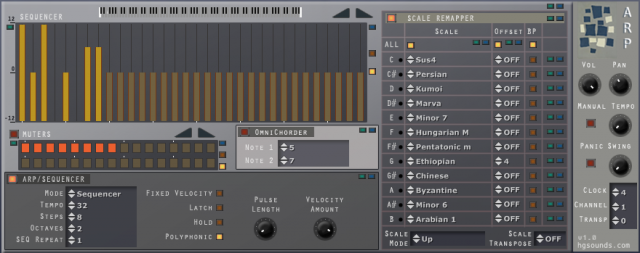
Homegrown Sounds has introduced ARP, an advanced polyphonic arpeggiator and note sequencer with scale remapping for powerful sequencing possibilities.
Here’s what they have to say about it:
With ARP, sequences can be re-mapped based on the played note – so, for example, a sequence can be forced to fit to the major scale. The idea behind this is to break away from the typical note sequencer where every key simply transposes the sequence, the ability to remap each note results in a much more creative sequence.
The Muter Section is a gate sequencer which decides which notes will play. ARP is also polyphonic and so can be used as a typical Gate Sequencer, or even more interesting as a polyphonic sequencer that syncopates. There is also the ability to offset the start note of each sequence so that when 2 notes are pressed together they automatically play syncopated. Finally there is OmniChorder which allows triggering up to another 2 notes when one note is pressed to create a chord, this becomes interesting when used with the Scale Remapper which can leave you with a selection of interesting one finger chords.
The demo version is fully featured, but times out after 10 minutes, it can downloaded here.
Full Feature List:
- Arpeggiator – Can be used as a classic ARP with the usual UP/Down/Alternate modes.
- Note/Sequence Repeats – This is used to play the note or sequence x amount of times before moving to the next note in sequence.
- 32 Note Sequencer Mode – This has a 2 octave range, centre value represents actual note pitch.
- 32 Note Muters – Basically a gate sequencer that decides if a note should play or not, can be used with the Sequencer or the Arpeggiator.
- 1-4 Octaves – Once the sequence is complete it will go up an octave as far as 4 Octaves.
- Fixed Velocity Mode – can use a fixed Velocity instead of played velocity, which is set via a knob.
- Latch Mode – Holds the note until the next one is played.
- Pulse Width – When Latch is off, this determines how long the pulse is, affecting how long the note trigger is held.
- Hold – This will hold any pressed keys until hold is depressed.
- OmniChorder – This can be used along with the Sequencer and also when the ARP is disabled. It allows setting 2 further notes to trigger to form a chord from pressing one key. Once this is enabled, the Scale Remapper can be used to manipulate the chord for each note in the octave, reminiscent of the classic Omnichord.
- Scale Remapper – Allows changing the Scale on each note (C – B) so that a sequence can be squashed to the scale:
- Over 70 scales to choose from.
- Sequence Offset – This allows offsetting the start note of each sequence when it is triggered. For example in Poly Mode pressing 2 keys together will start both sequences running, one could be set to start on step 2 so that it will syncopate. In Monophonic mode it allows building more complex sequence patterns as they iterate.
- Pitch Disable per note – This can prevent a sequence playing on the selected note, so that for example note C won’t play the sequence but just C notes. This is useful in Polyphonic mode so that one key can be consistent whilst another note can play a sequence alongside it.
- 7 Scale Mapping Modes – The mode decides how the scale is altered, when a note doesn’t match the scale, Up will select the next above, Down the next one down etc. There is also nearest, furthest and alternate. There is also a mode which holds the pitch of the octave, and simply uses the scale remapper to force the scale, useful for music without key changes.
- Works with the OmiChorder even when the ARP/Sequencer is switched off.
- Polyphonic – When used with a polyphonic instrument, notes can trigger individual sequences which is great for use with the Muters(Gate Sequencer) which can create complex rhythmic patterns.
- Midi Out – Can be used with any software or hardware midi instrument with host that support midi routing such as Reaper and Cantabile.
- Midi Volume and Pan – These can be used to set the volume and Pan of external gear (CC7 and CC10).
- Midi Channel – Use this to set which midi channel should be used.
- Manual Tempo – Normal Operation is based on the Host Tempo so that it remains in sync with the project, however manual mode can be used in the fashion of an old analog sequencer.
- Swing – Swing can be applied when the tempo is set to 32, speed can be reduced by changing the master clock tempo.
- Full VST Automation.
- Global / Local Randomizer/Default Buttons.
ARP for Windows (VST) is available now for US $20.

This is pretty SicK!
Some pretty amazing features. Been looking for a better arp/seq than on the one included in ableton.
A steal for $20. Too bad there is no OS X version.